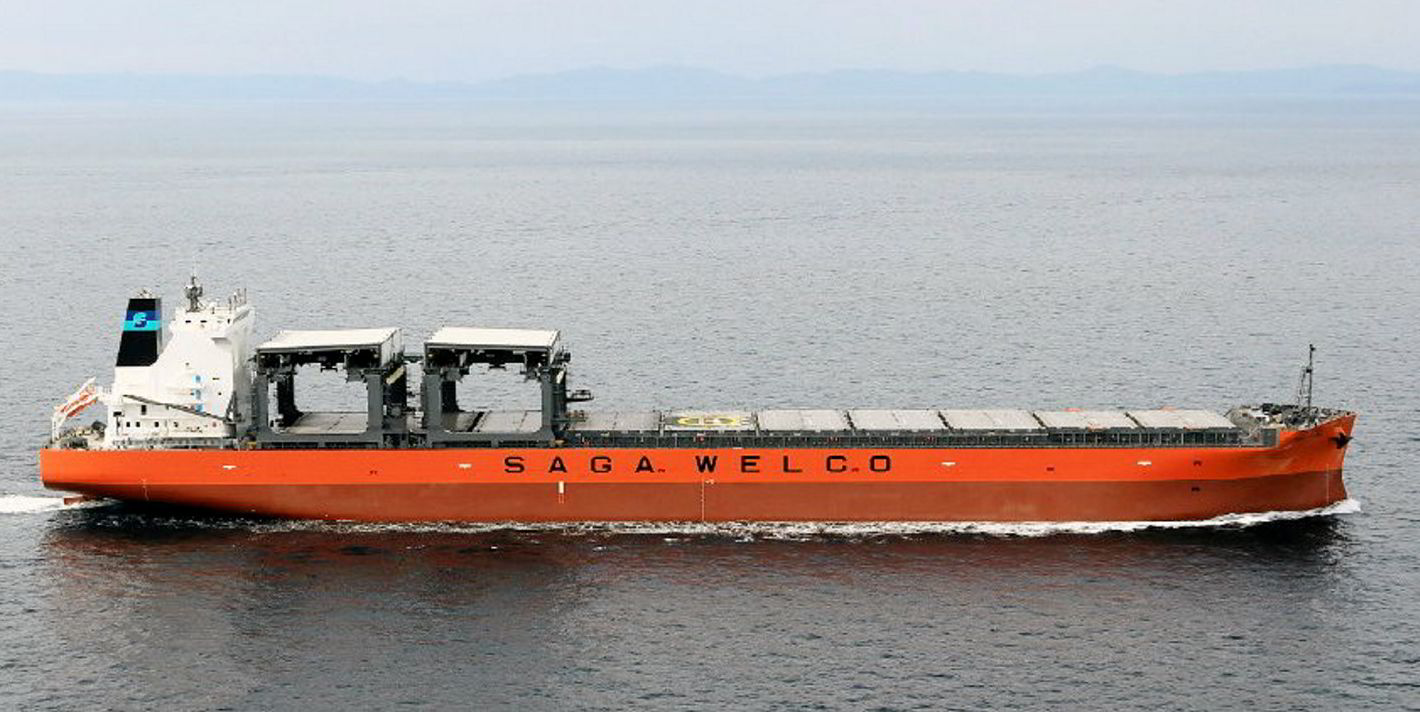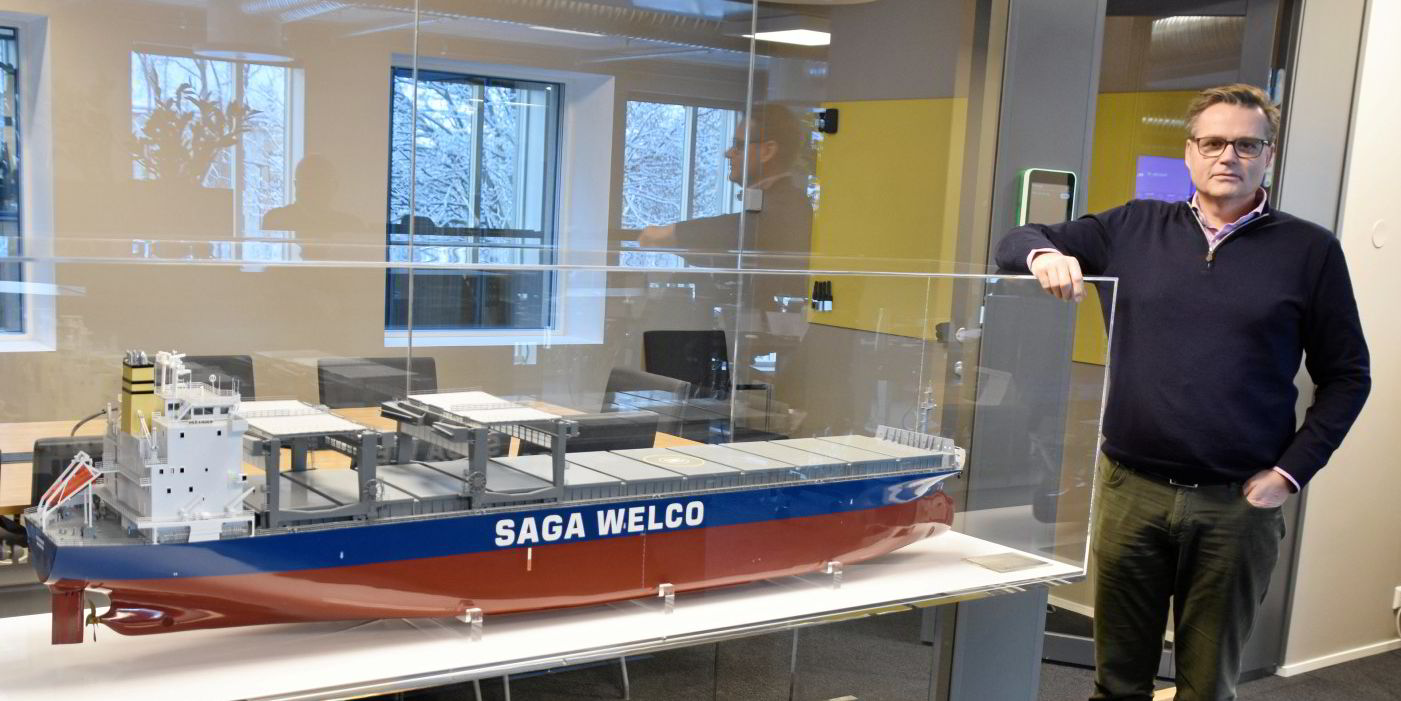Saga Shipholding and Westfal-Larsen, the owners behind Norway’s Saga Welco open-hatch pool, are pondering a renewal of their large, uniform, custom-designed fleet.
Customers like the covered moving gantry cranes that are the Saga trademark. But the expensive kit does not generate a significant chartering premium.
And competition with Cosco may force the Saga Welco partners to move up from the present supramax tonnage bracket to panamax.
So said Katsuhito Yamane and Gisle Rabe, managing director and chief financial officer respectively of Tonsberg-based Saga Shipholding, which is owned by Japan’s NYK Line.
Saga Shipholding and private family-owned Westfal-Larsen of Bergen are equal shareholders in the operating pool Saga Welco. The name incorporates the brands of both partners, but Saga Shipholding contributes the majority of the tonnage.
The Saga Welco fleet consists of 49 open-hatch bulkers of 47,000 dwt to 56,000 dwt, built from 1994 to 2019, with newbuildings on pause since before the pandemic.
Of those, 33 ships are contributed from Saga Shipholding (six on charter from Norwegian partners) and 16 from Masterbulk, a subsidiary of Westfal-Larsen.
Saga Shipholding acknowledges the renewal dilemma.
“We need to renew the fleet sooner or later but at this moment the newbuilding price is very high and interest rates are increasing,” Yamane said. “That makes it difficult to decide.”
There is pressure to renew as some ships approach their 30th birthday, in part because of the Carbon Intensity Indicator (CII) factor.
However, there is no straight-line relationship between age and fuel consumption. Most of the Saga Shipholding ships have estimated CII ratings of B and C, with a couple of chartered-in vessels expected to turn in a D.
Unique opportunity
Rabe said the 47,000-dwt Saga Wind (built 1994) and Saga Sky (built 1996) have very good CII ratings.

“We had vessels scrapped in 2021 at the age of 30 years that would do almost as well on CII as our 2008-built vessels,” Yamane said.
But because of their straight-hulled construction, open-hatch vessels have one unique technical opportunity for enhancing their CII ratings: they can be elongated at a cost of about $5m with a midbody extension that increases cargo capacity while leaving fuel consumption and speed almost exactly the same, yielding a higher CII.
Westfal-Larsen has already elongated three ships, most recently in 2016, and with the advent of CII, this is likely to happen with Saga Shipholding vessels.
“I think we can get the price under $5m,” Rabe said.
And in general, Saga Shipholding is comfortable with spending money in the dry dock.
“A sixth special survey is still cheaper than ordering newbuildings,” Yamane said.
For competitive reasons, the next generation of ships needs to be bigger, especially to compete with Cosco Specialized Carriers’ larger, lower-cost ships.
But Japan’s Oshima Shipbuilding may have priced itself out of the market. Covered travelling gantry cranes from Oshima add up to $10m per vessel over conventional upright jib cranes.
“Saga Welco tells us that most customers prefer the gantry crane but they won’t pay for it,” Yamane said. “Customers may prefer cheaper tonnage, if it is reflected in the freight rates.”
Rabe said: “In order to stay in business in the long run we will need newbuildings. But right now, like most owners, we consider the prices too high.”
Saga Welco’s larger Norwegian competitor — the G2 Ocean Pool, run by Grieg Star Shipping and Gearbulk Holding — has a similar age profile but with a mix of gantry and jib.
But it is Cosco that Saga Shipholding looks to as the competitive challenge, and potentially also as a threat to profitability through over-tonnaging.
“To keep the same tonnage level, our vessels should be larger but possibly somewhat fewer,” Yamane said.
“Probably we would build 70,000-dwt open-hatch vessels with jib cranes. Only Cosco is aggressive to order newbuildings now. And as long as Cosco remains aggressive, we should be modest, because the market could collapse.”
High costs plus the spectre of Cosco and its access to cheaper tonnage make it “too risky to order right now”, according to Rabe, but the conservative attitude could pay off in the end.
As long as Cosco remains aggressive, we should be modest, because the market could collapse
— Katsuhito Yamane
“We have good relations with the Japanese shipbuilding industry through NYK, and our Norwegian staff have good relations with Norwegian ship technology companies,” Yamane said.
“If environmental requirements are higher, this will be an advantage for Saga Shipholding.”





